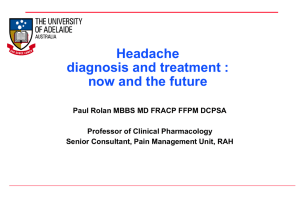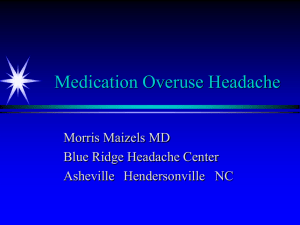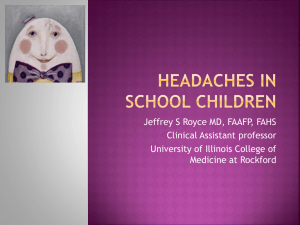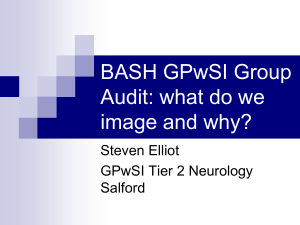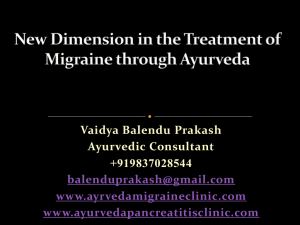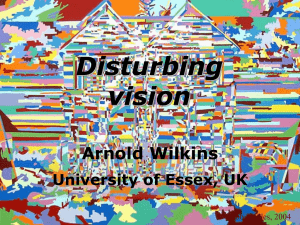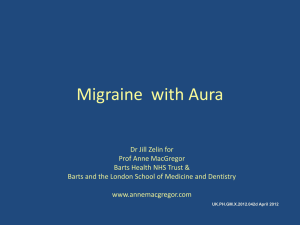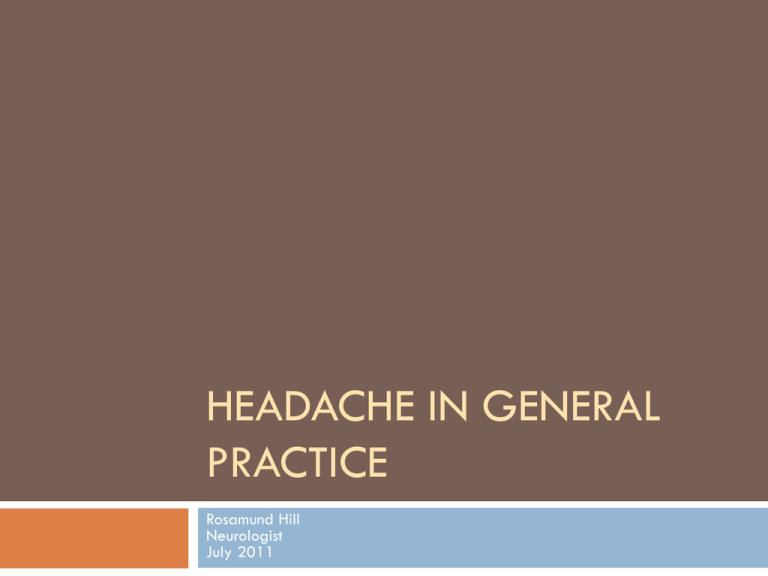
HEADACHE IN GENERAL
PRACTICE
Rosamund Hill
Neurologist
July 2011
Headache
What sort of headache? What is the diagnosis?
Primary or secondary headache? Could there be a
serious underlying cause for the headache?
Management and treatment
“IF WOMEN ARE SO BLOODY PERFECT AT
MULTITASKING, HOW COME THEY CAN’T
HAVE SEX AND A HEADACHE AT THE SAME
TIME?”
Billy Connolly
Secondary headache
Infection – meningitis, sinusitis
Inflammatory – giant cell arteritis, SLE
Intracranial pathology – tumour, SAH, subdural, avm
Medication – MOH, alcohol induced, caffeine, opioid, estrogen
withdrawal
Musculoskeletal – TMJ, cervical myofascial or joint dysfunction
Neuralgia- post herpetic neuralgia, trigeminal neuralgia
Systemic illness
HISTORY AND NEUROLOGICAL EXAMINATION
BRAIN IMAGING
Brain imaging
New onset headache
Definite change in pre-existing headache
Focal neurological findings
Thunderclap headache
Sex headache
CT vs MRI
International Classification of Headache(2004)
Primary Headaches
Migraine without aura
Migraine with aura
Tension type headache
Trigeminal Autonomic Cephalgias (TACs)
Cluster headache
Paroxysmal hemicrania
SUNCT
Other primary headaches
migraine
Migraine without aura
4 to 72 hrs duration
Unilateral, pulsing quality, mod to severe pain, aggravated by usual
physical activity
At least one of :
nausea and/or vomiting, photophobia and phonophobia
Migraine with aura
Fully reversible visual and/or sensory and/or speech sxs but no motor
weakness
Headache begins during the aura or follows aura within 60 mins
tension-type headache
Bilateral location, non-pulsating quality, mild-to-moderate intensity, not
aggravated by routine physical activity.
Not nausea but can have photophobia or phonophobia.
cluster headache and other
trigeminal autonomic cephalgias
Cluster headache (episodic or chronic)
Intermittent, excruciating, sharp/stabbing
Ipsilateral autonomic sign (conjunctival inj, lacrimation, nasal congestion,
rhinorrhea, eyelid oedema, forehead and facial sweating, miosis or ptosis)
15-180 mins, up to 8/day
Paroxysmal hemicrania
At least 20/day, 2 to 30 mins, absolute response to indomethacin
SUNCT (short-lasting, unilateral, neuralgiform headache with conjunctival
injection and tearing)
Very rare, 5 to 240 secs, up to 300/day
other primary headaches
Primary stabbing headache
Primary cough headache
Primary exertional headache
Primary headache associated with sexual activity
Hypnic headache
Hemicrania continua
New daily-persistent headache
Primary stabbing headache
Paroxysmal , very short (often less than 1 sec) pain attacks which occur as
single or as repetitive pain stabs.
Affect a circumscribed area, usually in VI
Stabbing, mild to mod intensity
1 a year to 100 a day
More common in patients with other headache disorders
Spontaneous or triggered eg. Cold ice or drinks, ice-pick like pain
No cranial autonomic symptoms
Pathophysiology unknown
Usually no treatment
Indomethacin if very frequent 25 to 50 mg bd
Try melatonin, nifedipine, gabapentin.
Primary cough headache
Sudden onset and lasts one second to 30 minutes.
Triggered by coughing or valsalva
11 to 50 % of cases cough ha is symptomatic, most common is ArnoldChiari type 1, other causes incl post fossa mass, craniocervical
abnormalities, non-ruptured aneurysms.
Mean age of onset 55 to 65 and men 3-5 x more common than women.
Often spontaneous remission, usually 2 months to 2 years.
Usually no treatment, avoid coughing.
Indomethacin 50mg bd range 25 to 200mg, mean duration of treatment 6
mths to 4 years. Alternative is acetazolamide, or topamax, LP
Primary exertional headache
Triggered by different types of physical exercise eg weight lifting,
swimming and running.
Pulsating headache lasting 5 mins to 48 hours.
22 to 43% of cases are secondary – SAH, cervical artery dissection,
Arnold-Chiari malformation, post fossa lesions, intracranial venous
anomalies or stenoses.
Usually in early adult years.
Co-morbidity with primary ha associated with sexual activity in about 40%
and 46% have migraine.
Spontaneous remission is common.
Avoid exercise or slow increase esp in heat or high altitude.
Indomethacin or propranolol or short term prophylaxis with indomethacin
25 to 50 mg 1 hour before exercise.
Primary headache associated with sexual activity
•
•
•
•
•
•
•
•
•
•
•
Not assoc with other sorts of physical activity but pts can also have exertional
or cough headache. Independent to the kind of sexual practice.
Orgasmic(3-4 x more common) or pre-orgasmic.
Pain is bilateral, diffuse or occipital.
Usually about 30 mins and up to 24 hours.
Exclude secondary headache (11% of SAH occur during sexual activity)
Mechanism of disorder is unknown.
Usu spontaneously remit but can last days to yrs and recur.
Men 3 to 4 x more frequent
Spontaneously remit.
Treatment is to stop as soon as headache starts.
Panadol, voltaren, aspirin or nurofen ineffective, triptans can settle ha, 5075mg indomethacin is recommended prophylactically (80% response).
Hypnic headache
Almost every night (at least every week) a occurs headache during sleep
typically at the same time each night.
Pulsating or dull, moderate, 30 mins to 3 hours, bilateral frontotemporal or
diffuse.
No assoc autonomic symptoms.
Usually starts over the age of 50.
Main problem is disturbed sleep.
Only treat if impaired quality of life
Strong coffee or oral caffeine at bedtime, or lithium, indomethacin.
Primary thunderclap headache
Sudden headache of maximal intensity similar to that of a ruptured
aneurysm with normal imaging and CSF.
In the acute headache phase, diffuse, segmental or multifocal vasospasms in
all vessel territories without evidence of aneurysm or bleeding.
Vasospasm is completely reversible.
Reversible cerebral vasoconstriction syndrome.
Usually once in a lifetime.
Can be triggered by heat.
Other disorders can cause sudden severe headache and need to be
considered.
No data on prevalence, women>men, mean age 45 (25-67)
Treat acutely with paracetamol and opioids.
Hemicrania Continua
First described in 1984
Continuous pain with increases in severity, can have mild cranial autonomic
features.
Need to ensure no medication overuse.
Prevalence unknown, women 1 ½ times more freq than men.
Usually starts between age 20 and 30.
Response to indomethacin is a diagnostic criteria.
25 mg tds increasing to 225mg per day.
Single case reports of verapamil, naproxen, caffeine, lamotrigine,
gabapentin, methysergide, topiramate, melatonin or steroids.
New daily persistent headache
First described in 2004.
Difficult to distinguish from chronic tension-type ha.
Acute or subacute onset – within 3 days and then continuous.
Resembles chronic t-t ha but can have migrainous features.
Usu bilateral, mostly not pulsating, dull and mild to mod intensity.
No preceding episodic ha with increasing frequency.
Consider medication overuse.
Post infectious occurrence considered.
M=F, onset 10 to 30 or 50 to 60 yrs.
No evidence based treatment recommendation but expert consensus agrees
treatment is very difficult. Treatment choice depends on primary features.
“IF YOU HAVE A LOT OF TENSION, AND YOU
GET A HEADACHE, DO WHAT IT SAYS ON THE
ASPIRIN BOTTLE “TAKE TWO ASPIRIN” AND
“KEEP AWAY FROM CHILDREN”
headache management
Good working relationship with the patient
Trial and error – rarely a simple fix!
Manage expectations
Diary of headache and medication use
Regular consultations
Headache diary – www.migraineclinic.org.uk
tension-type headache
Simple analgesics – paracetamol, NSAIDs, aspirin
Prevention – tricyclics, gabapentin, topamax, epilim
Management of stress and tension
Exercise
Watch for MOH
migraine pathophysiology
Migraine is an inherited, episodic multisystem disorder involving sensory
processing/ sensitivity to internal and external stimuli.
Current thinking is that a primary neuronal dysfunction leads to a sequence
of changes intra and extracranially. Blood vessels are intimately involved
but vasodilatation is probably an epiphenomenon.
Genetic insights from study of familial hemiplegic migraine.
Aura in 30% of patients, neurally driven, cortical spreading depression, self
propogating wave of neuronal and glial depolarisation that spreads across
the cerebral cortex.
Trigeminovascular system
acute treatment of migraine
Triptan is the treatment of choice for migraine.
Contraindications include pregnancy, age, cardiac history, previous
adverse effects of triptans.
A number of patients will respond to simple analgesics early in the
course of the headache.
If no contraindications to use of a triptan, then which might be the most
suitable triptan and which route of delivery?
Is nausea present?
Oral vs subcutaneous vs nasal spray.
acute treatment of migraine
rizatiptan(maxalt) 10mg
sumatriptan 50-100 mg
zolmitriptan(zomig) 5mg intranasal spray
(recurrence, triptan-specific side effects and cardiovascular safety)
- Studies confirm early treatment produces greater efficacy (START
study 2010, 62% 2 hr pain-free vs 35%).
- In non-responders to sumatriptan, rizatriptan was found to be
effective (2 hr pain relief 51%, pain freedom 22%)
(2010,Cephalalgia)
(cafergot or codeine phosphate or tramadol)
acute treatment of migraine
Paracetamol rapid 1g +\- NSAID
paramax 2 tabs +\- NSAID
Naproxen sodium 550mg–825mg
Ibuprofen 400-1200 mg
Diclofenac supps or dispersible tabs 50 – 100mg
soluble aspirin 900-1000mg
caffeine – panadol extra, coffee, coke
anti-emetics – maxolon, buccastem, ondansetron *
When to add preventive treatment
Generally a minimum of 2 to 4 disabling migraines per month.
Assess effectiveness of acute treatment.
Evaluate other medical conditions to help in decision making
regarding preventive drug eg. depression, hypertension, sleep
issues, weight issues.
Preventive treatment
50% reduction in 50% of patients
Propranolol use 10 or 40mg tabs and increase to 80mg bd
Amitriptyline or nortriptyline 10mg to 100mg/day (occ up to 150mg)
Topamax 75-100mg/day, maximum 200mg/day
Epilim use 200mg tabs and increase gradually to 600 to 800mg bd
Gabapentin use 100mg tabs beginning with 100mg od to tds and increase
to 300mg tds and then to 900mg tds
SSRIs *
Chronic Daily Headache
Primary headache occurring on at least 15 days of the month.
3 to 5% of the population.
Usually a mixture of tension-type headache and migraine.
About 10% of this group have new daily persistent headache.
Often complicated by head injury and medication overuse.
Often accompanied by mood disorder.
Increased risk of “chronification” of migraine also occurs with obesity,
caffeine intake and stress. *
Medication Overuse Headache (MOH)
Simple analgesics no more than 10-15 days/month
Opiates or triptans no more than 8-10 days/month
Avoid combination medications! *
Medication overuse headache
•
•
Any analgesic can cause MOH!
A neurobehavioural disorder.
– Physical receptor alterations.
– Behavioural – excessive/obsessive drug-taking, anticipatory
anxiety, fear of pain.
Many use drugs to cope with life and stress, even when not
valuable for pain.
Treatment of MOH
Multidimensional approach
Discontinuation of daily medication.
Preventive therapy to limit headache occurence and/or
severity.
Diary. (the London Migraine Clinic Headache Diary)
May need iv dihydroergotamine protocol as inpatient.
Websites with info for doctors and patients
www.americanheadachesociety.org
www.migraine.org.uk
www.migraine4kids.org.nz
www.headaches.org
Migraine
Botox
Menstrual migraine
Pregnancy
Complementary and alternative approaches
Interventional treatments
Role of brain imaging
Menstrual Migraine
Day -2 to +3
Migraine without aura
Estrogen patches – poor result
Mini-prophylaxis with NSAIDs and/or sumatriptan
Tricycle coc pill or reduced pill-free interval or supplemental
estrogen
Stop ovulation with cerazette or depo provera.
Special areas in treatment of migraine
•
•
Menopause – if go in with episodic better than CDH
Pregnancy
–
–
•
Tca’s, beta-blockers
Paracetamol, diclofenac 25-50mg ( not first trimester and not for more
than or 3 consecutive days), codeine
Complementary and alternative treatments
–
–
–
–
–
Riboflavin (vitamin B2) 400 mg/day
Magnesium
Coenzyme Q10
Vitamin D
Iron supplements
Special areas in treatment of migraine
Diet
Dairy free diet minimum of 3 weeks
Gluten free diet minimum of 3 months
Exercise – very important!!!!
Massage and acupuncture
“Healing Headaches” by Jim Bartley
Brain Imaging
Br J Gen Pract 2010;60(581):897-901
Impact of GP direct-access computerised tomography for the
investigation of chronic daily headache.
Simpson GC et al
4404 scans on pts referred by GPs in Glasgow from 1999-2007.
10.5% reported abnormal findings ; potentially causative in
1.4% of pts .
Most patients (86%) did not require specialist referral.
Acute treatment of migraine
rizatiptan(maxalt) 10mg or sumatriptan 50-100 mg or
zolmitriptan(zomig) 5mg intranasal spray
(recurrence, triptan-specific side effects and cardiovascular safety)
- Studies confirm early treatment produces greater efficacy (START study
2010, 62% 2 hr pain-free vs 35%).
- In non-responders to sumatriptan, rizatriptan was found to be effective
(2 hr pain relief 51%, pain freedom 22%) (2010,Cephalalgia)
+/- NSAID or aspirin (short acting forms)
+/- anti – nausea medication
+/- paracetamol rapid 1g or paramax
(codeine phosphate or tramadol)
Acute treatment of migraine
Paracetamol rapid 1g +\- NSAID
paramax 2 tabs +\- NSAID
Naproxen sodium 550mg–825mg
Ibuprofen 400-1200 mg
Diclofenac supps or dispersible tabs 50 – 100mg
soluble aspirin 900-1000mg
caffeine – panadol extra, coffee, coke
anti-emetics – maxolon, buccastem, ondansetron
Advances in the acute treatment of migraine
A RCT on 346 pts showed efficacy of paracetamol 1g with 52%
headache relief at 2hrs vs 32% for placebo but no difference in pain
freedom at 2 hrs.
Cochrane meta-analysis of 10 studies confirmed superiority of
paracetamol over placebo and concluded that the addition of 10mg
of metoclopramide gives equal efficacy to sumatriptan 100mg.
Cochrane meta-analysis confirmed ibuprofen is effective but patients
are seldom pain-free.
PARACETAMOL IS LESS POTENT THAN ASPIRIN.
NAPROXEN AND IBUPROFEN CAN BE ALMOST AS EFFECTIVE AS
SUMATRIPTAN ORAL.
When to add preventive treatment
Generally a minimum of 2 to 4 disabling migraines per month.
Assess effectiveness of acute treatment.
Evaluate other medical conditions to help in decision making
regarding preventive drug eg. depression, hypertension, sleep
issues, weight issues.
Preventive treatment
50% reduction in 50% of patients
Propranolol use 10 or 40mg tabs and increase to 80mg bd
Amitriptyline or nortriptyline 10mg to 100mg/day (occ up to 150mg)
Topamax 75-100mg/day, maximum 200mg/day
Epilim use 200mg tabs and increase gradually to 600 to 800mg bd
Gabapentin use 100mg tabs beginning with 100mg od to tds and increase
to 300mg tds and then to 900mg tds
Preventive treatment
SSRIs or SNRIs
Sandomigran 0.5mg to 4mg, mostly at night
Candarsartan 16mg/day
Verapamil
Lamotrigine
Advances in the preventive treatment of migraine
BMJ 2010;341:c5222
Tricyclic antidepressants and headaches: systematic review and metaanalysis. Jackson JL
37 randomised trials of tricyclics in adults with ha treated for ≥ 4 wks
Tricyclics reduced days with t-t ha and attacks of migraine cf placebo but not
SSRIs.
With longer duration of treatment the effect of tcas increased with decreased
intensity of headache and migraine.
Tcas useful for migraine, t-t ha and mixed headache.
Ideal dose in not clear. Duration needs to be 3-6 months.
Advances in the preventive treatment of migraine
Topiramate is currently one of the best studied preventive drugs.
It can be effective for migrainous vertigo even at a small dose of
50mg/day.
Cannot stop the development of chronic daily ha but reduces overall ha
days.
Its effectiveness may be due to augmentation of the GABAa receptor,
modulation of sodium channels, glutamate receptor antagonism, carbonic
anhydrase protein kinase inhibition, possible serotonin activity or
alteration of neuroinflammatory factors.
Advances in the treatment of migraine
Retrospective study(Heart, 2010) of patent foramen ovale closure
reported improvement (34% migraine-free and 48% improved).
(JACC Cardiovasc intervention 2010) Outcome of PFO closure in a
selected group of 40 pts with refractory migraine and anatomical and
functional characteristics supposedly predisposing to ischaemic events
showed improvement in all patients and and auras eliminated in 100%
of pts.
The only prospective randomised, double-blind, multicentre controlled
trial (MIST) enrolled 147 pts migraine with aura, and at 6 mths no
benefit shown.
Advances in the treatment of migraine
Occipital nerve block or supraorbital nerve block in chronic migraine.
Occipital nerve stimulation – 66 pts treated and at 3 mths 39% of pts
had at least 50% reduction in monthly headache days compared to 6%
in the control group with 1 min stimulation vs 0 in placebo group.
BOTOX – efficacy in chronic migraine but
? Gain over placebo may not be clinically relevant
? Patients had MOH not chronic migraine
40% had not tried preventive medication
Chronic Daily Headache
Primary headache occurring on at least 15 days of the month.
3 to 5% of the population.
Usually a mixture of tension-type headache and migraine.
About 10% of this group have new daily persistent headache.
Often complicated by head injury and medication overuse.
Often accompanied by mood disorder.
Increased risk of “chronification” of migraine also occurs with obesity,
caffeine intake and stress.
Medication Overuse Headache (MOH)
Simple analgesics no more than 10-15 days/month
Opiates or triptans no more than 8-10 days/month
Avoid combination medications!
Medication overuse headache
Any analgesic can cause MOH!
A neurobehavioural disorder.
Physical receptor alterations.
Behavioural – excessive/obsessive drug-taking, anticipatory
anxiety, fear of pain.
Many use drugs to cope with life and stress, even when not
valuable for pain.
Treatment of MOH
Multidimensional approach
Discontinuation of daily medication.
Preventive therapy to limit headache occurence and/or
severity.
Diary. (the London Migraine Clinic Headache Diary)
May need iv dihydroergotamine protocol as inpatient.
Menstrual Migraine
Day -2 to +3
Migraine without aura
Estrogen patches – poor result
Mini-prophylaxis with NSAIDs and/or sumatriptan
Tricycle coc pill or reduced pill-free interval or supplemental
estrogen
Stop ovulation with cerazette or depo provera.
Special areas in treatment of migraine
Menopause – if go in with episodic better than CDH
Pregnancy
Tca’s, beta-blockers
Paracetamol, diclofenac 25-50mg ( not first trimester and not for more
than or 3 consecutive days), codeine
Complementary and alternative treatments
Riboflavin (vitamin B2) 400 mg/day
Magnesium
Coenzyme Q10
Vitamin D
Iron supplements
Special areas in treatment of migraine
Diet
Dairy free diet minimum of 3 weeks
Gluten free diet minimum of 3 months
Exercise – very important!!!!
Massage and acupuncture
“Healing Headaches” by Jim Bartley
Brain Imaging
Br J Gen Pract 2010;60(581):897-901
Impact of GP direct-access computerised tomography for the
investigation of chronic daily headache.
Simpson GC et al
4404 scans on pts referred by GPs in Glasgow from 1999-2007.
10.5% reported abnormal findings ; potentially causative in
1.4% of pts .
Most patients (86%) did not require specialist referral.
Websites with info for doctors and patients
www.americanheadachesociety.org
www.migraine.org.uk
www.migraine4kids.org.nz
www.headaches.org
Migraine pathophysiology
PACAP and VIP produce equal craniovascular vasodilation.
Vasodilation is an epiphenomenon only.
Ergotamine causes vasoconstriction but vascular changes are not associated
closely with the pain.
3T MRA demonstrated migraine triggered by GTN was not associated with
change in vessel calibre.
“The vascular theory has been constricted in its evidence base”.
Replaced by the neurovascular theory of migraine.
Acute treatment of migraine
rizatriptan 10mg wafer
sumatriptan orally 50-100mg
sumatriptan injection
zolmitriptan nasal spray
cafergot
codeine phosphate or tramadol
Primary headache
Migraine with or without aura
Tension-type headache
Paroxysmal autonomic cephalgias
Cluster headache
Paroxysmal hemicrania
SUNCT
Other primary headaches
Over 300 illnesses cause headache as a symptom!
Temporal arteritis
Subarachnoid/ subdural haemorrhage
Idiopathic intracranial hypertension
Intracranial hypotension
Carotid/vertebral artery dissection
Cerebral vasculitis
Reversible cerebral vasospasm
Meningitis
Cerebral vein thrombosis
Arnold chiari malformation
Migraine pathophysiology
Activation of the trigeminovascular system – small sensory neurons that
originate from the trigeminal ganglion and upper cervical dorsal roots and
innervate large cerebral vessels, pial vessels, dura and large venous sinuses.
Trigeminal nerve and upper cervical nerve roots converge on trigeminal
nucleus caudalis ( this accounts for the distribution of pain involving head
and upper neck).
Activation of the trigeminal ganglion also results in release of vasoactive
neuropeptides (subst P, CGRP) that cause neurogenic inflammation –
vasodilation and plasma protein extravasation.

